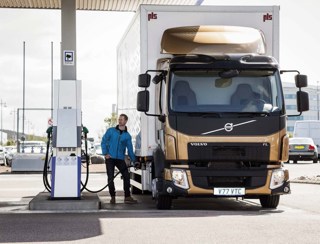Most alternative fuels come with baggage; everything from charging points and specialised dispensers to extra pipework and unique storage facilities. All this infrastructure costs money, takes up space and requires extra staff training.
The beauty of running on 100% hydrotreated vegetable oil (HVO) is that none of this is required. An aromatic-free paraffinic diesel that can be used as a drop-in substitute for mineral diesel, it can be stored in the same bulk tank and used in exactly the same way, say its proponents.
A second-generation biofuel made from renewables such as used cooking oil and animal fat from food industry waste, its big advantage is its low CO2 figure.
“It can help users reduce greenhouse gas emissions by up to 90% compared with fossil diesel,” says Peter Zonneveld (pictured), vice president sales, renewables, Europe and Asia Pacific at leading producer Neste. The Finnish company markets the fuel under the Neste MY Renewable Diesel banner.
“Scientific studies and field trials have shown that it produces 33% fewer particulates than fossil diesel,” he continues. Hydrocarbon emissions are down by 30%, carbon monoxide output is reduced by 24%, and NOx (nitrogen oxide) emissions by 9%, he adds.
Truck maker Daf is a big supporter of HVO.
Phil Moon, UK marketing manager at Daf says: “Let’s suppose you run a truck that covers 100,000 miles annually at an average 10mpg, which means it burns 10,000 gallons/45,400 litres of fossil diesel a year. That means it emits 121.6 tonnes of CO2 yearly, but if you switch to HVO you can cut that figure by 109.5 tonnes.”
The UK Government aims to reduce vehicle greenhouse gas emissions to net zero by 2050 under its Road to Zero strategy. HVO, while not the full solution, could offer a stepping-stone while other technologies are developed.
“HVO has no maintenance or fuel economy implications, and you can mix it with fossil diesel in a bulk tank,” Moon says.
Nor is it difficult to store. “It’s a more stable fuel than ordinary diesel, with a low water content,” he adds.

Moon makes the point that using HVO does not affect a truck’s second-hand value. With other types of alternative fuel the residuals can be more uncertain, he contends.
Says Zonneveld: “Growth prospects for HVO are very solid in Nordic countries thanks to ambitious renewable fuels targets aimed at cutting transport CO2 emissions substantially by 2030. In Sweden, the share of biofuels in road transport is around 20% while in Finland and Norway the share is 15%.”
Aside from Neste, other producers include Total, Repsol and Eni. All HVO has to be made to the same EN15940 standard and production is expanding.
HVO is available from a small number of distributors in the UK, with Green Biofuels playing a key role. Among the fuel’s drawbacks is the price. It is around 10% to 15% more expensive than mineral diesel. That cost will not be recouped through fuel savings: efficiency is only marginally better than diesel. Testing by Cummins a few years ago on Euro 5 showed just a 2.3% fuel saving. The benefits, therefore, are entirely emissions-based.
And, unlike in Scandinavian countries, HVO does not enjoy a UK duty concession despite its environmental credentials. Instead, the Department for Transport (DfT)is using the Renewable Transport Fuel Obligation to promote its adoption. It means fuel producers have to ensure a percentage of the product they supply is made from renewables.
Neat HVO is not available from public forecourts in the UK – if you want to use it you will have to store it in your own bulk tanks – and not all manufacturers are willing to allow it to go into their vehicles.
Van makers divided
While truck makers are happy to endorse its use, van makers are more equivocal. Some approve it for their entire range, others approve it for some models but not others, and yet others do not approve it at all.
“The reality is that it should work perfectly well in any modern diesel engine,” says independent transport industry consultant, Martin Flach, formerly alternative fuels director at Iveco. “Where it has not been approved then it is probably because the manufacturer concerned has been so busy working on battery-electrical vehicles that it has not got round to testing it.”
Fleets should therefore get written confirmation that HVO is approved for use in a vehicle before they fill up the tank. Failure to do so could invalidate the warranty.
Some operators may be worried about palm oil being used as an HVO feedstock given the links between its production and deforestation. Suppliers are aware of this concern and are addressing it, conscious that it will have to be phased out in mainland Europe by 2030 in line with the European Union’s sustainability standards, says FuelsEurope.
Palm oil mill effluent is on the list of wastes used to produce the HVO that Green Biofuels sources from Neste.
ICSS approval
“Under our ICSS (International Sustainability and Carbon Certification) approval, however, it has to be generated from plantations planted before 2007,” says Green Biofuels chief operating officer, Magnus Hammick.
“It is hazardous, has no other use, and making it into a fuel avoids it going into a landfill.”
A growing number of UK operators are trialling HVO and are adopting it for at least some of their vehicles.
“We supplied 10 million litres in 2019, we should reach 50 million litres this year and our target for 2021 is 350 million,” Hammick says. “We should achieve a billion litres in 2022.”
Among those fleets leading the charge is the London Borough of Hackney.
It operates 90 trucks, including skip wagons and hook loaders as well as RCVs, and plans to run them all on HVO, says corporate fleet manager Norman Harding. “We’re going battery-electric for our LCVs and cars,” he adds.
His recommendation that the council switches to HVO is in partly based on evidence from independent trials conducted at the Millbrook Proving Ground in Bedfordshire.
They confirmed that the fuel’s CO2 benefits are even better than those claimed by Neste, with a saving of up to 94% on a stop-start test designed to simulate a Euro VI RCV’s urban duty cycle.
A subsequent trial of an RCV on a mixture of urban and rural routes involving operators such as Veolia and Biffa saw a similar level of CO2 saving. Substantial cuts in NOx emissions were achieved in both cases.
“We’ve trialled the fuel ourselves and we haven’t had a problem with it,” Harding says. “Cold starting, for example, has been fine.”
Hammick says the Green D+ HVO Green Biofuels can offer features such as an additive which, among other things, chemically reduces the amount of NOx in the exhaust gases.
“CO2 is down by 96% compared with fossil diesel, particulates by more than 85% and NOx by 30%,” he states.
A number of other fleets have used HVO with some success, including Power Electrics, which supplies mobile generators. Price remains an issue for some operators, however, in the light of pinched profit margins; not to mention the need to preserve cash as the UK emerges from the Covid-19 crisis.
GTL
HVO is not the only drop-in paraffinic diesel being produced. GTL – the initials stand for gas-to-liquid – can cut NOx by up to 37% and particulates by a hefty 90% compared with mineral diesel, says Certas Energy, which markets Shell GTL in the UK.
Like HVO, GTL costs several pence a litre more than standard diesel – expect just 5% over conventional diesel. However, because it is made from a fossil fuel, its CO2 reduction is a tiny fraction of that of its rival. Its raison d’etre, therefore, is for air quality improvement rather than tackling climate issues.



















Matthew Aron Cohen - 22/02/2023 19:57
Cummins published a test that confirms what most testing has shown...that HVO REDUCES fuel economy by 5%. It does not improve it. https://www.cummins.com/news/2022/07/01/hydrotreated-vegetable-oil-hvo-explained